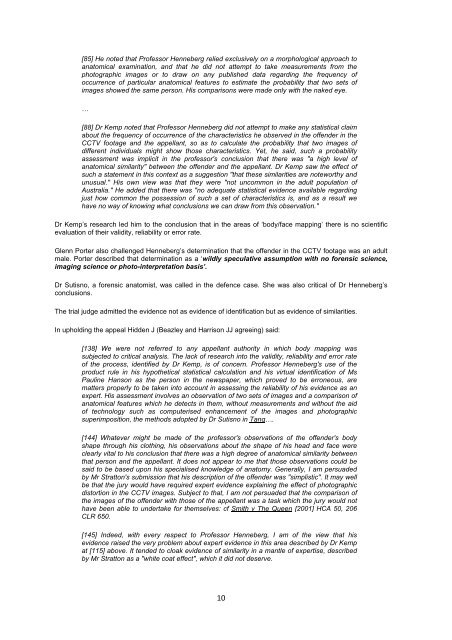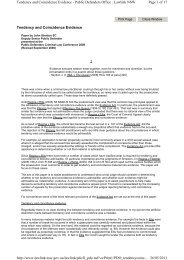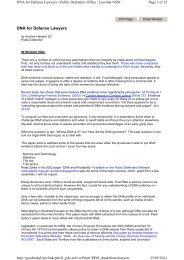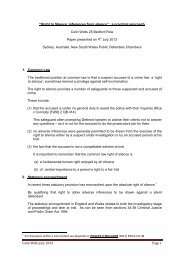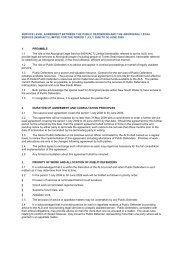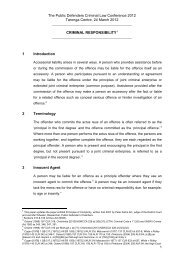Expert Evidence, by Dina Yehia SC - The Public Defenders
Expert Evidence, by Dina Yehia SC - The Public Defenders
Expert Evidence, by Dina Yehia SC - The Public Defenders
You also want an ePaper? Increase the reach of your titles
YUMPU automatically turns print PDFs into web optimized ePapers that Google loves.
[85] He noted that Professor Henneberg relied exclusively on a morphological approach to<br />
anatomical examination, and that he did not attempt to take measurements from the<br />
photographic images or to draw on any published data regarding the frequency of<br />
occurrence of particular anatomical features to estimate the probability that two sets of<br />
images showed the same person. His comparisons were made only with the naked eye.<br />
…<br />
[88] Dr Kemp noted that Professor Henneberg did not attempt to make any statistical claim<br />
about the frequency of occurrence of the characteristics he observed in the offender in the<br />
CCTV footage and the appellant, so as to calculate the probability that two images of<br />
different individuals might show those characteristics. Yet, he said, such a probability<br />
assessment was implicit in the professor's conclusion that there was "a high level of<br />
anatomical similarity" between the offender and the appellant. Dr Kemp saw the effect of<br />
such a statement in this context as a suggestion "that these similarities are noteworthy and<br />
unusual." His own view was that they were "not uncommon in the adult population of<br />
Australia." He added that there was "no adequate statistical evidence available regarding<br />
just how common the possession of such a set of characteristics is, and as a result we<br />
have no way of knowing what conclusions we can draw from this observation."<br />
Dr Kemp’s research led him to the conclusion that in the areas of ‘body/face mapping’ there is no scientific<br />
evaluation of their validity, reliability or error rate.<br />
Glenn Porter also challenged Henneberg’s determination that the offender in the CCTV footage was an adult<br />
male. Porter described that determination as a ‘wildly speculative assumption with no forensic science,<br />
imaging science or photo-interpretation basis’.<br />
Dr Sutisno, a forensic anatomist, was called in the defence case. She was also critical of Dr Henneberg’s<br />
conclusions.<br />
<strong>The</strong> trial judge admitted the evidence not as evidence of identification but as evidence of similarities.<br />
In upholding the appeal Hidden J (Beazley and Harrison JJ agreeing) said:<br />
[138] We were not referred to any appellant authority in which body mapping was<br />
subjected to critical analysis. <strong>The</strong> lack of research into the validity, reliability and error rate<br />
of the process, identified <strong>by</strong> Dr Kemp, is of concern. Professor Henneberg's use of the<br />
product rule in his hypothetical statistical calculation and his virtual identification of Ms<br />
Pauline Hanson as the person in the newspaper, which proved to be erroneous, are<br />
matters properly to be taken into account in assessing the reliability of his evidence as an<br />
expert. His assessment involves an observation of two sets of images and a comparison of<br />
anatomical features which he detects in them, without measurements and without the aid<br />
of technology such as computerised enhancement of the images and photographic<br />
superimposition, the methods adopted <strong>by</strong> Dr Sutisno in Tang….<br />
[144] Whatever might be made of the professor's observations of the offender's body<br />
shape through his clothing, his observations about the shape of his head and face were<br />
clearly vital to his conclusion that there was a high degree of anatomical similarity between<br />
that person and the appellant. It does not appear to me that those observations could be<br />
said to be based upon his specialised knowledge of anatomy. Generally, I am persuaded<br />
<strong>by</strong> Mr Stratton's submission that his description of the offender was "simplistic". It may well<br />
be that the jury would have required expert evidence explaining the effect of photographic<br />
distortion in the CCTV images. Subject to that, I am not persuaded that the comparison of<br />
the images of the offender with those of the appellant was a task which the jury would not<br />
have been able to undertake for themselves: cf Smith v <strong>The</strong> Queen [2001] HCA 50, 206<br />
CLR 650.<br />
[145] Indeed, with every respect to Professor Henneberg, I am of the view that his<br />
evidence raised the very problem about expert evidence in this area described <strong>by</strong> Dr Kemp<br />
at [115] above. It tended to cloak evidence of similarity in a mantle of expertise, described<br />
<strong>by</strong> Mr Stratton as a "white coat effect", which it did not deserve.<br />
10


